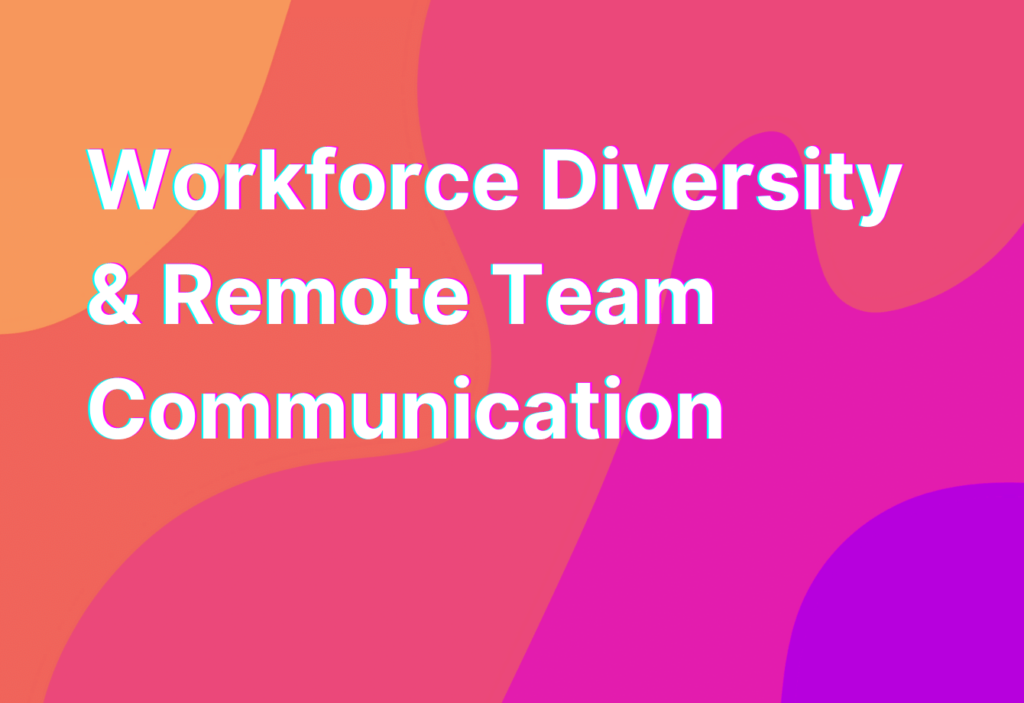Workforce Diversity & Remote Team Communication
Workforce diversity is a hot topic in today’s business world. Companies are recognizing the importance of having a diverse team that brings different perspectives and experiences to the table. And with the rise of remote work, the need for effective communication within diverse teams has become even more crucial. In this article, we will explore the challenges and benefits of workforce diversity in remote team communication.
The Challenges of Workforce Diversity in Remote Team Communication
While workforce diversity can bring many advantages to a team, it also presents unique challenges when it comes to remote team communication. Here are some of the common challenges that organizations face:
- Cultural differences: When working with a diverse team, it’s important to be aware of cultural differences that may impact communication. Different cultures have different communication styles, norms, and expectations. For example, some cultures may value direct and assertive communication, while others may prefer a more indirect and polite approach. Being mindful of these differences can help foster effective communication within the team.
- Language barriers: In a diverse team, language barriers can pose a significant challenge to effective communication. Not everyone may be fluent in the team’s common language, leading to misunderstandings and misinterpretations. It’s important to establish clear communication channels and provide language support when needed to ensure everyone can effectively participate in team discussions.
- Time zone differences: Remote teams often span across different time zones, making synchronous communication challenging. Team members may have to adjust their schedules to accommodate meetings and collaboration. It’s important to establish clear expectations regarding availability and find ways to ensure everyone has equal opportunities to contribute, regardless of their time zone.
- Communication tools: Remote teams rely heavily on communication tools to stay connected and collaborate. However, not all team members may be familiar with or have access to the same tools. It’s important to provide training and support to ensure everyone can effectively use the chosen communication tools and platforms.
- Building trust: Trust is essential for effective communication within any team, but it can be particularly challenging to build trust in a remote and diverse team. Without face-to-face interactions, it can be harder to establish rapport and develop personal connections. It’s important to create opportunities for team bonding and foster a culture of trust and inclusivity.
The Benefits of Workforce Diversity in Remote Team Communication
While there are challenges, workforce diversity also brings numerous benefits to remote team communication. Here are some of the advantages:
- Enhanced creativity and innovation: A diverse team brings together individuals with different backgrounds, perspectives, and experiences. This diversity of thought can lead to enhanced creativity and innovation. When team members approach problems from different angles, they are more likely to come up with unique and innovative solutions.
- Improved decision-making: Diverse teams are more likely to consider a wider range of perspectives when making decisions. This can lead to more well-rounded and informed decisions. By incorporating different viewpoints, teams can avoid groupthink and make better choices.
- Increased adaptability: Remote teams often face unique challenges and changing circumstances. A diverse team is better equipped to adapt to these changes and find creative solutions. Different perspectives and experiences can help the team navigate through uncertainty and come up with effective strategies.
- Expanded market reach: A diverse team can better understand and connect with a diverse customer base. By having team members from different backgrounds, organizations can gain insights into different markets and tailor their products or services to meet the needs of a wider range of customers.
- Enhanced cultural intelligence: Working in a diverse team can improve cultural intelligence, which is the ability to understand and adapt to different cultural contexts. This skill is becoming increasingly important in today’s globalized world and can benefit individuals in their personal and professional lives.
Overall, workforce diversity brings both challenges and benefits to remote team communication. By being aware of and addressing the challenges, organizations can create an inclusive and effective communication environment. Embracing diversity can lead to enhanced creativity, improved decision-making, and increased adaptability, ultimately driving success in remote teams.
Wrapping Up
Workforce diversity is a valuable asset in remote team communication. While it presents challenges such as cultural differences, language barriers, and time zone variations, the benefits outweigh the difficulties. Diverse teams bring enhanced creativity, improved decision-making, increased adaptability, expanded market reach, and enhanced cultural intelligence. By embracing diversity and fostering effective communication, organizations can create successful remote teams.
If you’re interested in learning more about remote team communication and project management, check out our article on Agile project management and remote team communication. It provides valuable insights and tips for managing remote teams effectively.


